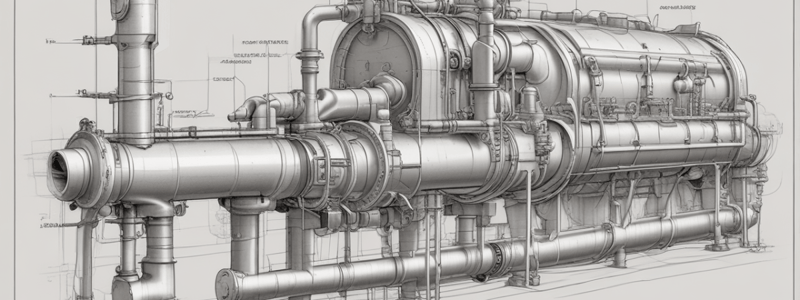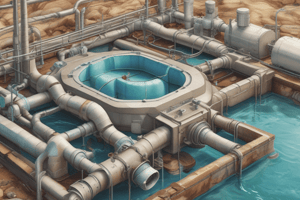Podcast
Questions and Answers
What is the main difference between intermittent and continuous sedimentation tanks?
What is the main difference between intermittent and continuous sedimentation tanks?
- Intermittent tanks are circular in plan, while continuous tanks are long rectangular.
- Intermittent tanks keep water in complete rest, while continuous tanks only reduce flow velocity. (correct)
- Intermittent tanks have horizontal flow, while continuous tanks have radial flow.
- Intermittent tanks have high flow velocity, while continuous tanks bring water to complete rest.
Why are long rectangular basins preferred over circular basins for settling tanks?
Why are long rectangular basins preferred over circular basins for settling tanks?
- Circular basins facilitate easier sludge scraping.
- Circular basins have a shorter settling zone.
- Long rectangular basins are hydraulically more stable. (correct)
- Long rectangular basins have radial or spiral flow.
What is the purpose of the sludge zone in a long rectangular settling tank?
What is the purpose of the sludge zone in a long rectangular settling tank?
- To collect sludge below the settling zone. (correct)
- To uniformly distribute flow over the cross section.
- To collect and discharge clarified effluent.
- To facilitate settling under quiescent conditions.
Why is the bottom of a long rectangular settling tank slightly sloped?
Why is the bottom of a long rectangular settling tank slightly sloped?
How is the flow controlled in long rectangular settling basins?
How is the flow controlled in long rectangular settling basins?
What functional zone in a long rectangular settling tank collects and discharges clarified effluent?
What functional zone in a long rectangular settling tank collects and discharges clarified effluent?
What type of inlets should be designed to distribute water equally and at uniform velocities?
What type of inlets should be designed to distribute water equally and at uniform velocities?
Why are peripheral weirs not acceptable in settling basins?
Why are peripheral weirs not acceptable in settling basins?
What is the purpose of having a baffle close to the inlet in a settling basin?
What is the purpose of having a baffle close to the inlet in a settling basin?
What determines the size particle that can be completely removed in the settling zone?
What determines the size particle that can be completely removed in the settling zone?
What is the retention time in the settling zone for particle removal?
What is the retention time in the settling zone for particle removal?
Which velocity component is used to determine the path of particles in a settling basin?
Which velocity component is used to determine the path of particles in a settling basin?
What is not a factor in determining the size particle that can be removed completely in the settling zone?
What is not a factor in determining the size particle that can be removed completely in the settling zone?
Why are circular settling basins easier to maintain compared to long rectangular basins?
Why are circular settling basins easier to maintain compared to long rectangular basins?
$t_0=V=LZ_0W$. If $t_0$ corresponds to the time required for a column to be carried horizontally across the settling zone, what will happen to particles with $v_t
$t_0=V=LZ_0W$. If $t_0$ corresponds to the time required for a column to be carried horizontally across the settling zone, what will happen to particles with $v_t
$Q$ is mentioned in connection with which of the following factors to determine overflow rate?
$Q$ is mentioned in connection with which of the following factors to determine overflow rate?
What is the assumed detention period for the design of the sedimentation tank?
What is the assumed detention period for the design of the sedimentation tank?
What is the relationship between the length (L) and breadth (B) of the rectangular tank?
What is the relationship between the length (L) and breadth (B) of the rectangular tank?
Which type of colloids are solvent hating and irreversible upon heating?
Which type of colloids are solvent hating and irreversible upon heating?
What is the main reason for the stability of colloids?
What is the main reason for the stability of colloids?
What mechanism is responsible for destabilizing a colloidal dispersion by changing the characteristics of the medium?
What mechanism is responsible for destabilizing a colloidal dispersion by changing the characteristics of the medium?
'Flocculation' in water treatment refers to...
'Flocculation' in water treatment refers to...
What does the electrical double layer in a colloidal dispersion contain?
What does the electrical double layer in a colloidal dispersion contain?
'Tyndall effect' is observed in colloidal solutions due to...
'Tyndall effect' is observed in colloidal solutions due to...
'Brownian motion' in colloids is caused by...
'Brownian motion' in colloids is caused by...
What is the purpose of rapid mixing in water treatment?
What is the purpose of rapid mixing in water treatment?
In what type of flocculation do colloidal particles collide due to fluid motion from stirring?
In what type of flocculation do colloidal particles collide due to fluid motion from stirring?
What is the acceptable range for head loss during rapid mixing in water treatment?
What is the acceptable range for head loss during rapid mixing in water treatment?
Which factor is used to estimate velocity gradient (G) in a fluid system?
Which factor is used to estimate velocity gradient (G) in a fluid system?
What is the mechanism by which Al(III) and Fe(III) salts destabilize colloids in water treatment?
What is the mechanism by which Al(III) and Fe(III) salts destabilize colloids in water treatment?
What purpose does a jar test serve in water treatment?
What purpose does a jar test serve in water treatment?
Which type of flocculation involves colloidal particle collisions due to Brownian motion?
Which type of flocculation involves colloidal particle collisions due to Brownian motion?
What is the primary role of mechanical flocculators in water treatment?
What is the primary role of mechanical flocculators in water treatment?
How do Al(III) and Fe(III) salts destabilize colloids when added to water?
How do Al(III) and Fe(III) salts destabilize colloids when added to water?
What allows adjustments of pH, coagulant dose, and mixing speed in water treatment processes on a small scale?
What allows adjustments of pH, coagulant dose, and mixing speed in water treatment processes on a small scale?
What is the purpose of the jar testing apparatus?
What is the purpose of the jar testing apparatus?
What is the purpose of the rapid mix stage in the jar test procedure?
What is the purpose of the rapid mix stage in the jar test procedure?
Which filtration mechanism is due to the force of gravity and settling velocity of particles?
Which filtration mechanism is due to the force of gravity and settling velocity of particles?
What is the role of gravel in the filtration process using sand as a filter media?
What is the role of gravel in the filtration process using sand as a filter media?
How is the size of sand particles expressed?
How is the size of sand particles expressed?
What does slow sand filter consist of?
What does slow sand filter consist of?
In the jar test procedure, what is done after allowing containers to settle for 30 to 45 minutes?
In the jar test procedure, what is done after allowing containers to settle for 30 to 45 minutes?
"What does diffusion towards media granules occur for according to the text?"
"What does diffusion towards media granules occur for according to the text?"
What is the Carman-Kozeny equation used to calculate?
What is the Carman-Kozeny equation used to calculate?
What is the recommended action if a filter run reaches a given hour of operation?
What is the recommended action if a filter run reaches a given hour of operation?
What phenomenon occurs if the resistance offered by the filter media exceeds the static head of water above the sand bed?
What phenomenon occurs if the resistance offered by the filter media exceeds the static head of water above the sand bed?
What is the main cause of cracking in rapid sand filters?
What is the main cause of cracking in rapid sand filters?
What is the primary function of backwashing a rapid sand filter?
What is the primary function of backwashing a rapid sand filter?
What should be done to prevent formation of mud balls in rapid sand filters?
What should be done to prevent formation of mud balls in rapid sand filters?
What action is recommended if the filter no longer produces water at the desired rate?
What action is recommended if the filter no longer produces water at the desired rate?
What is the main issue associated with long filter runs without backwashing?
What is the main issue associated with long filter runs without backwashing?
How does air binding affect the filtering process in rapid sand filters?
How does air binding affect the filtering process in rapid sand filters?
What is the purpose of breaking the top fine mud layer with rakes in rapid sand filters?
What is the purpose of breaking the top fine mud layer with rakes in rapid sand filters?
What is the primary method of cleaning Rapid-sand filters?
What is the primary method of cleaning Rapid-sand filters?
Which filter consists of two or more layers of different granular materials?
Which filter consists of two or more layers of different granular materials?
What process removes impurities in slow sand filters by straining and adsorption?
What process removes impurities in slow sand filters by straining and adsorption?
What is the purpose of the layer referred to as 'Schmutzdecke' in slow sand filtration?
What is the purpose of the layer referred to as 'Schmutzdecke' in slow sand filtration?
Which filter type is suitable for treating waters with low colors, low turbidities, and low bacterial contents?
Which filter type is suitable for treating waters with low colors, low turbidities, and low bacterial contents?
What is the primary base material size difference between Sand Filters and Rapid Sand Filters?
What is the primary base material size difference between Sand Filters and Rapid Sand Filters?
Which filter type requires post-treatment disinfection as a must?
Which filter type requires post-treatment disinfection as a must?
What is the primary method of cleaning Slow Sand Filters?
What is the primary method of cleaning Slow Sand Filters?
What is one major difference between Slow Sand Filters and Rapid Sand Filters?
What is one major difference between Slow Sand Filters and Rapid Sand Filters?
Which characteristic makes Rapid Sand Filters more flexible compared to Slow Sand Filters?
Which characteristic makes Rapid Sand Filters more flexible compared to Slow Sand Filters?
Flashcards are hidden until you start studying





